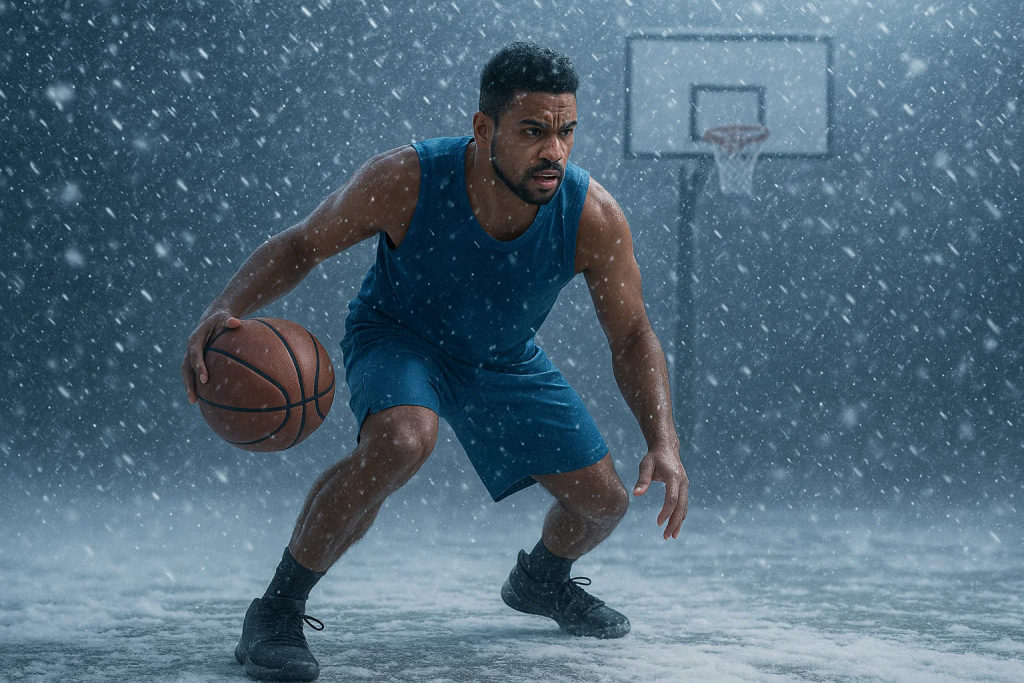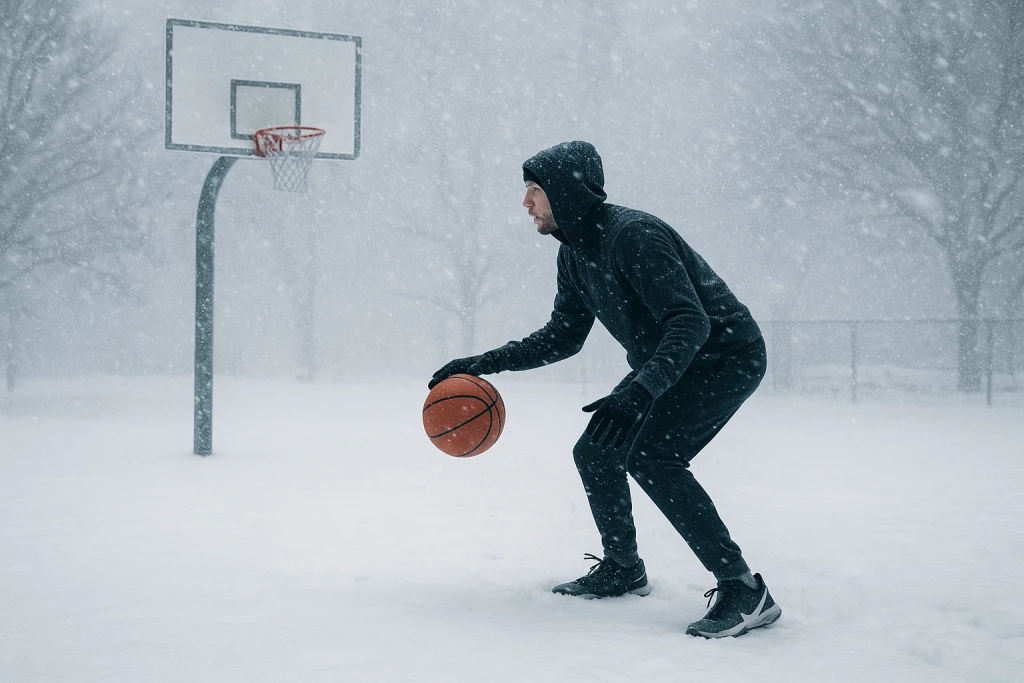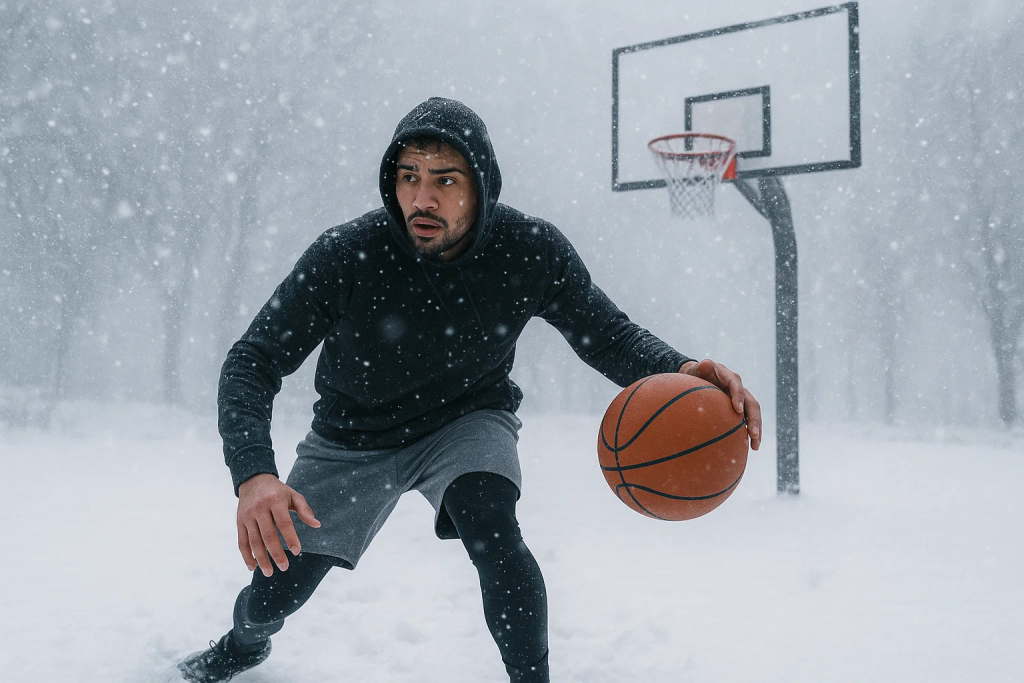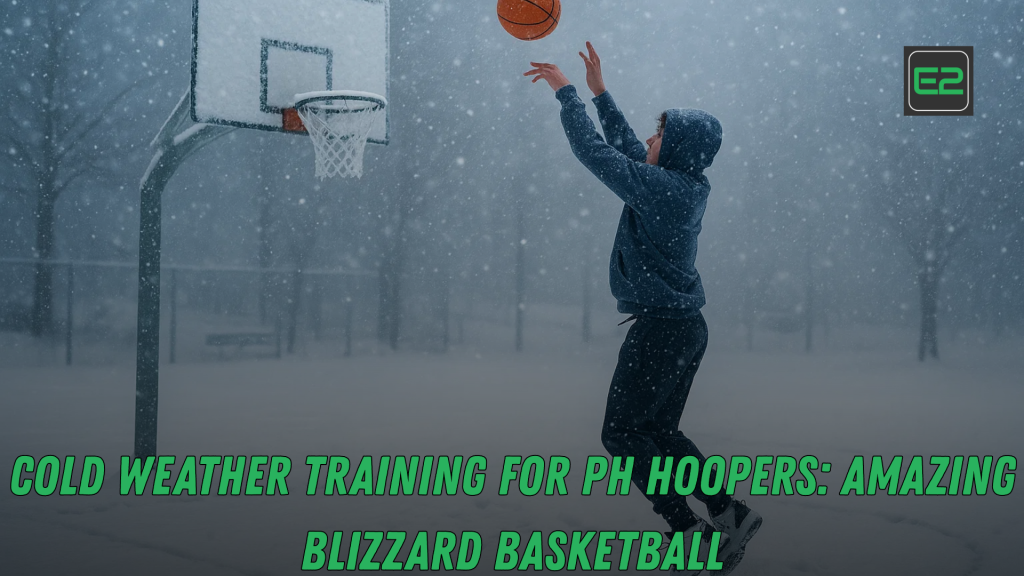Table of Contents
Executive Summary
Filipino hoopers are built on grit, pace, and creativity—often forged under the sun. But regional tours, overseas tryouts, winter leagues, and training camps demand another skill: playing well in the cold. “Blizzard Basketball” is your blueprint to prepare, perform, and protect your body when temperatures drop. You’ll learn layering and gear, thermoregulation basics, cold-specific warm-ups, ball handling and shooting adjustments, footing and traction upgrades, breathing and recovery, nutrition for cool climates, and a 30–60–90 day plan that moves you from tropical player to all-weather pro—safely.
Quick win: In cold conditions, longer warm-ups, lighter layers that wick sweat, and slightly higher ball pressure are immediate performance boosters.

Why Cold-Weather Training Matters for Filipino Hoopers
- Global schedules: Exposure to winter leagues (Japan B.League, Europe), holiday tournaments, and overseas tryouts often means indoor gyms with chilly air or outdoor sessions in near-zero temps.
- Performance stability: Cold stiffens muscles and tendons, slows nerve conduction, and reduces ball bounce—killer for handle and shot rhythm unless you adapt.
- Durability & injury risk: Strains and pulls increase when you sprint from a warm locker room into cold air. Proper prep reduces tweaks and keeps you on the floor.
- Competitive edge: Most tropical athletes under-prep for cold. Nail this, and you gain an instant edge abroad.
The Science: How Cold Changes Your Hoopers Game
- Muscle function & stiffness
- Cold reduces muscle elasticity and slows the rate of force development. Translation: first step feels heavy, pull-ups feel tight, and you’re late on contests.
- Joint viscosity
- Synovial fluid thickens when cold; your knees and ankles may feel “rusty.”
- Breathing & lungs
- Cold, dry air can irritate airways. Expect coughing, mild bronchospasm, or extra effort on long defensive possessions.
- Ball physics
- Air contracts in the cold; ball pressure drops and bounce softens.
- Sweat dynamics
- You still sweat, but moisture chills you faster. That’s why wicking layers matter.
Bottom line: Cold is beatable when you raise tissue temperature, protect airways, adjust your gear, and modify the ball/court setup.
Hoopers Gear That Wins in the Cold (From Head to Toe)
Layering Rule: Base (wick), Mid (warm), Shell (block wind). You’ll shed layers as your core temp rises.
- Head & neck: Lightweight beanie or headband for outdoor warm-ups; neck gaiter you can pull down during drills.
- Base layer: Compression top/leggings with moisture-wicking fabric (avoid cotton next to skin).
- Mid layer: Light hoodie or quarter-zip you can remove quickly.
- Shell: Wind-resistant jacket for outdoor drills; not needed once you’re sweating.
- Hands: Thin receiver-style gloves for outdoor ball handling; indoors, warm hands pre-session (hand warmer packets pre-shootaround if allowed).
- Socks: Merino or synthetic blends; consider doubling if shoes allow.
- Footwear: Basketball shoes with winterized rubber if outdoors; otherwise, rotate fresh outsoles for grip. Traction mat or sandpaper pad in your bag.
- Accessories:
- Lacrosse ball or mini-roller for soft-tissue prep.
- Portable pump with gauge for ball pressure.
- Towel to keep the ball and hands dry.
- Thermal bottle for warm electrolyte tea (ginger/lemon + a pinch of salt/sugar).
Warm-Up: Hoopers Cold-Specific Protocol (12–18 Minutes)
Goal: Raise core temperature, mobilize joints, activate prime movers, then sharpen the nervous system.
0–3 min: Heat on
- Jump rope or jog with high knees, butt kicks, carioca. Keep hoodie on.
3–6 min: Mobility + dynamic
- Ankle rocks (front/back, side/side), deep squat pry, world’s greatest stretch, T-spine rotations.
- Leg swings (front/back & lateral), arm circles, band pull-aparts.
6–10 min: Activation
- Mini-band: lateral walks, monster walks.
- Glute bridge → single-leg bridge, plank shoulder taps, dead bug breathing (through the nose).
10–14 min: Potentiation
- A-skips, lateral bounds (small → medium effort), 2–3 short accelerations (10–15 m).
- Two contrast jumps: countermovement jump → depth landing focus (stick control).
14–18 min: Basketball-specific
- Ball feel: fingertip taps, pound dribbles (R/L), wrap series.
- Shooting primer: 10 form shots (1–2 dribbles, focus arc), 10 midrange catch-and-shoot, 5 corner threes at 60–70% effort.
Pro tip: If you step away from the court for >5 minutes (coach talk, drills reset), throw a hoodie back on and do 30–45 seconds of pogo hops or jump rope before resuming.
Hoopers Ball & Court Adjustments (Indoor Chill or Outdoor Cold)
- Ball pressure: Increase 0.5–1.0 psi above your tropical norm to offset cold-related softness. Test the bounce before practice.
- Grip management: Keep a dry towel courtside; wipe ball every water break.
- Footing:
- Indoors: wipe soles on a sticky mat; avoid dusty sidelines.
- Outdoors: check for black ice, wet leaves, slick paint; mark safe zones.
- Break cadence: Shorter breaks in cold; keep moving between stations to avoid cooling down.
Hoopers Skill Work That Translates in the Cold
Handles
- Heavier pound & cadence control: 2×30 sec pound series per hand; add change-of-height (low, mid, high) to force neuromuscular adjustment.
- Glove drills (outdoor only): 2–3 min total with thin gloves to exaggerate fingertip awareness; remove for live work.
Finishing
- High-body finishes: cold shoulders tighten—practice body-to-body layups that keep core braced.
- Two-step variations: inside/outside, stride stops, power jump off two; emphasis on landing mechanics to protect knees/ankles.
Shooting
- Arc before distance: Cold shortens release—start with form shots to reclaim arc.
- Game-speed catch-and-rise: 25 reps elbow → wing → corner, focus feet set early.
- Late-clock threes: 10 reps each side, simulate heavy legs; breathe out sharply at release to stabilize core.

Defense
- Short-burst slides: 3×20-sec at 80–90% with 40-sec rest; cold reduces quickness—train it.
- Close-out + hands high: drill with a cue to breakdown steps; no wild lunges on cold tendons.
Hoopers Conditioning Without Breaking in the Cold
Constraint: Cold amplifies muscle stiffness and fatigue; we condition smart, not just hard.
- Tempo intervals (indoor preferred): 6–8 sets of 17-second half-court shuttles, 43-second walk.
- Court fartlek: 12 minutes continuous—alternate 30 sec easy slides, 15 sec hard close-outs, 15 sec jog.
- Assault bike or treadmill (if available): 8×30 sec @ RPE 7–8 / 60 sec easy.
Recovery between sets: Keep upper body covered until heart rate normalizes; sip warm electrolytes.
Hoopers Breathing, Rhythm, and Focus (Cold-Air Advantage)
- Nasal-dominant inhale, soft mouth exhale during steady work to warm and humidify air.
- Reset between plays: one box breath (inhale 4, hold 2, exhale 6, hold 2) to calm nerves and keep hands steady.
- Cough reflex minimization: scarf/neck gaiter over mouth during outdoor jog warm-up.
Hoopers Recovery: Warmed-Up, Not Worn-Out
- Re-warm immediately: hoodie on, slow jog or bike 3–5 minutes post-practice.
- Mobility finisher: calves, hip flexors, glutes, T-spine (90–120 sec each).
- Contrast heat: warm shower first; if you use ice, do it briefly and not before skill sessions.
- Sleep: target 7–9 hours; cold rooms help sleep but avoid shivering (layer blankets).
- Soreness rule: More DOMS than usual? Shorten next day’s volume by 20–30%.
Hoopers Nutrition & Hydration for Cold Conditions
- Hydration still matters: You’re sweating even if you don’t feel it. Aim for ~250–350 ml every 15–20 minutes of hard work.
- Warm fluids: Try warm water + pinch of salt + honey or a low-sugar electrolyte mix; warm ginger tea pre-practice.
- Carbs for fuel: Oats, rice, pasta, potatoes—add a bit more on cold days.
- Protein: 1.6–2.0 g/kg/day spread across meals to support muscle repair.
- Fats for satiety & warmth: Nuts, avocado, olive oil—moderate portions.
- Pre-practice (60–90 min): banana + yogurt or peanut butter toast; avoid heavy oils.
- Post-practice (within 45 min): rice + chicken + greens or hot soup + bread + protein.
Injury Prevention: The Cold-Weather Watchlist
- Hamstrings & adductors: add RDLs, Copenhagen planks, and adductor sliders to S&C.
- Ankles: balance reaches, banded inversion/eversion, pogo hops.
- Knees: Spanish squats, split squats, step-downs; emphasize single-leg strength.
- Back/shoulders: thoracic rotations, band rows, Y-T-W raises.
- Red flags: sudden sharp pain, persistent cough/wheeze outdoors, numb fingers/toes → stop and warm up.
Hoopers Travel & Packing Checklist for Cold Camps/Tryouts
- 2–3 base layers (tops/leggings), 1–2 mid layers, 1 wind shell
- 2–3 practice shorts/jerseys, 4–6 pairs socks (merino/synthetic)
- Beanie, neck gaiter, thin gloves (outdoor drills)
- Ball pump with gauge, towel, traction mat, lacrosse ball
- Electrolyte packets, thermal bottle, light snacks
- Mini first-aid kit (tape, blister care), menthol rub if helpful
- Copies of ID/insurance, any asthma inhaler (if prescribed)
S&C Template (2–3x/week, 30–40 minutes, Indoors Preferred)
- Prep (6–8 min): foam roll calves/quads/glutes, band shoulder series, ankle mobility
- Power (6–8 min): box jumps 3×3, med-ball scoop toss 3×5/side
- Strength (12–15 min):
- A1) Trap-bar deadlift or goblet squat 3×5–8
- A2) Single-arm DB row 3×8/side
- B1) Split squat 3×6/side
- B2) Copenhagen plank 3×20–30 sec/side
- Tendon care (4–5 min): calf raises (straight + bent knee) 2×12–15
- Core (3–4 min): dead bug 2×8, side plank 2×20 sec/side
Keep total fatigue moderate so you’re fresh for skill work.
30–60–90 Day Cold-Weather Upgrade Plan
Days 1–30: Foundation & Gear
- Build the 12–18 min cold-specific warm-up habit.
- Acquire proper base/mid/shell layers and set a pre-practice hydration routine.
- Start S&C twice weekly; log RPE and soreness.
Benchmarks: Warm-up compliance ≥90%; no early-practice tightness.
Days 31–60: Skill & Conditioning
- Add handles + shooting progressions with ball pressure control.
- Introduce tempo intervals (shuttles) 1–2x/week.
- Practice breathing drills and shorten between-drill idle time.
Benchmarks: 5%+ improvement in conditioning test; steadier shot arc in cold gym.
Days 61–90: Game Simulation
- Full cold-tempo scrimmages 1–2x/week (short benches, high pace).
- Travel simulation: pack/run a mock cold session in layers.
- Fine-tune recovery (sleep, warm fluids, mobility finisher).
Benchmarks: Consistent first-quarter sharpness, reduced late-game cramping.
Sample 7-Day Microcycle (Cold Week)
- Mon: Skill + Conditioning (handles/shooting + shuttles), S&C light
- Tue: Team practice (sets & defense), extended warm-up
- Wed: Recovery (mobility + bike 20’ easy), form shooting
- Thu: Team practice (scrimmage), S&C power + tendon
- Fri: Shooting volume + situational plays (late-clock), short conditioning
- Sat: Game or heavy scrimmage (cold protocol), recovery smoothie/soup
- Sun: Off (walk 20–30’, stretch 15–20’)
Hoopers Mental Game: Composure When It’s Cold
- Routine trumps mood: same warm-up music, same first 10 shots, same breathing cue.
- Language: replace “ang lamig” with “I’m heating up” right after activation.
- Focus anchors: feel your big toe & pinky toe pressing the insole on close-outs; it centers balance fast.
Hoopers Safety Notes (Read This)
- If you have asthma or respiratory conditions, consult your doctor; carry prescribed inhalers.
- Watch for frostnip outdoors: numb ear tips/fingers—warm immediately.
- Never train in soaked clothing in wind; change layers quickly.
- Coaches: schedule more water breaks and watch for stiff movement patterns early in practice.
Call-to-Action (CTA)
Ready to become an all-weather hooper?
Reply “BLIZZARD PLAN” and I’ll send you:
- A printable 12–18 min warm-up card,
- A ball & court adjustment checklist,
- The 30–60–90 planner you can post in the locker room.
Turn cold gyms into your advantage—heat up faster, play longer, and finish stronger wherever basketball takes you.

Final Word
“Blizzard Basketball” isn’t about suffering through winter—it’s about owning it. With the right layers, the right warm-up, small ball/court tweaks, smart conditioning, and dialed-in recovery, Filipino hoopers can make cold gyms feel like home court. Train the protocol. Trust the plan. And when tip-off comes in a chilly arena, you’ll be the player who heats up first.
The guide shows Filipino hoopers how to convert cold conditions—from chilly indoor gyms to outdoor winter sessions—into a competitive edge by adjusting gear, warm-ups, skills, conditioning, and recovery. It explains the why: cold stiffens muscles and tendons, slows nerve conduction, thickens joint fluid, irritates airways, and softens ball bounce, all of which can sap first-step explosiveness, shot rhythm, and grip. The science-to-court translation is clear: raise tissue temperature, protect the airways, tweak the ball and court setup, and maintain movement between drills so you never “cool off.”
Gear & Setup. Use a three-layer system—base (wick), mid (warm), shell (wind block)—plus beanie/neck gaiter for outdoor warm-ups, merino/synthetic socks, and a traction mat or sandpaper for soles. Keep a pump to add +0.5–1.0 psi to ball pressure in cold gyms, and a towel to manage moisture.
Warm-Up (12–18 minutes). Progress from general heat (jump rope/jog) → mobility (ankle/squat/T-spine) → activation (mini-band walks, bridges, planks) → potentiation (bounds, accelerations) → basketball-specific (fingertip/handle sets, form shooting). Throw a hoodie back on during long coach talks and re-activate with brief hops before resuming.
Skill Adjustments. Handles: heavier pound dribbles, cadence/height changes, brief glove drills outdoors. Finishing: two-step and power-off-two variations with safe landings. Shooting: reclaim arc via form shots before distance; use game-speed catch-and-rise and late-clock threes with a crisp exhale at release. Defense: short-burst slides and controlled close-outs to protect cold tendons.
Conditioning & Recovery. Favor smart intervals (half-court shuttles, court fartlek) over sheer volume; sip 250–350 ml every 15–20 minutes (warm electrolytes work well). Post-session, re-warm with light cardio, perform targeted mobility, prioritize 7–9 hours of sleep, and use heat before ice. The injury watchlist targets hamstrings, adductors, ankles, knees, and shoulders with RDLs, Copenhagen planks, single-leg strength, thoracic mobility, and tendon care.
Nutrition. Cold training still dehydrates; pair warm fluids with electrolytes. Emphasize carbs for fuel, protein at 1.6–2.0 g/kg/day, and moderate healthy fats. Pre-session snacks should be light; refuel within 45 minutes post-practice.
Programming. A 30–60–90 day plan builds from gear/warm-up compliance, to skill + conditioning blocks, to game-simulation scrimmages; a sample 7-day microcycle balances skills, team practice, S&C, and recovery. The mental game centers on consistent warm-up routines, reframed self-talk (“I’m heating up”), and foot-pressure anchors for balance. Safety rules cover asthma planning, frostnip signs, avoiding soaked layers in wind, and coach-managed water breaks. The takeaway: with protocol, Filipino hoopers can heat up faster, play longer, and finish stronger in the cold.
Frequently Asked Questions (FAQ)
1) Can I just shoot more threes to warm up faster?
Not quite. In the cold, your tissues need heat before high-output jumps. Start with general warm-up + mobility + activation, then form shooting and catch-and-shoot at 60–70%. Add distance after your arc and rhythm return.
2) How much should I change ball pressure?
Increase ~0.5–1.0 psi over your usual to counter the colder air. Always test bounce and grip during warm-up and adjust a notch at a time.
3) Do compression tights really help?
Yes—as a base layer. They help with warmth and proprioception and wick moisture away from skin. Pair with a removable mid layer to avoid overheating once you’re rolling.
4) What if I only have outdoor access?
Double-down on layering, extend warm-up to 18–20 minutes, and use thin gloves briefly for ball feel work (remove for live drills). Check the surface for ice/slick spots and shorten breaks to keep core temp up.
5) I cramp in cold gyms—what now?
Cramping often blends under-hydration and electrolyte gaps. Sip 250–350 ml every 15–20 minutes, add sodium/potassium via electrolytes, and include a short mobility finisher post-practice. Avoid heavy caffeine right before workouts in dry, cold air.
